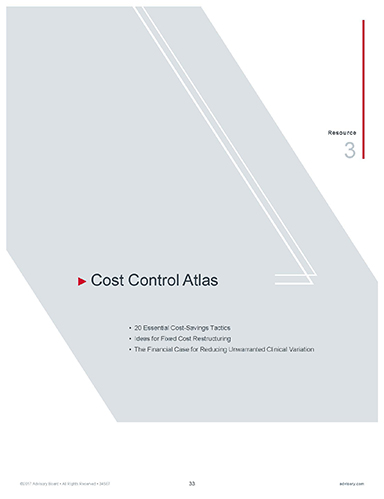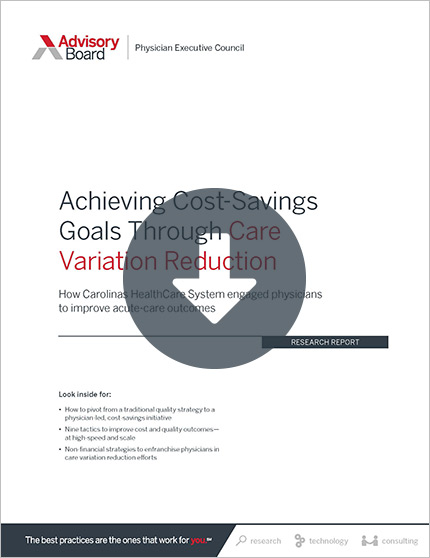Auto logout in seconds.
Continue LogoutAbout 30% of health care spending is considered wasteful. Here's how health systems including Johns Hopkins Health System and Kaiser Permanente are working to reduce that figure, and saving millions in the process, Maria Castellucci writes for Modern Healthcare.
Learn more: How to reduce avoidable cost and utilization
Why so much health spending is wasteful
According to the National Academies of Sciences, Engineering and Medicine, about 30% of health care spending is wasteful, including money spent on unnecessary tests and procedures as well as excessive administrative costs.
One driving factor, Castellucci writes, is that medical schools teach students to rule out all possibilities before reaching a diagnosis, which can lead physicians to order more tests than are truly necessary. Further, the widespread fee-for-service reimbursement model creates a financial incentive for providers to order more rather than less care.
But as the transition to value-based care continues, eliminating waste will become a higher priority. "The transition to value-based payment is going to be an important mechanism for the reduction of low-value services," Alexander Mainor, a research project coordinator at the Dartmouth Institute for Health Policy and Clinical Practice, said.
How Johns Hopkins reduced wasteful blood transfusions
In 2012, Johns Hopkins set its sights on reducing wasteful spending on blood transfusions, Castellucci writes. The procedure seemed like a promising area to cut costs, as studies estimate that as many as 40% of blood transfusions in the United States are unnecessary.
Historically, clinicians have defaulted to giving patients two units of blood when a transfusion is necessary, and "no one questioned the rationale behind it," Steve Frank, an anesthesiologist at Johns Hopkins, said. But recent research has shown that, in most cases, one unit of blood is sufficient when patients aren't actively bleeding.
So Johns Hopkins launched a multi-pronged effort to rein in unnecessary two-unit transfusions. Staff frequently began asking themselves, "Why give two when one will do?" The system also implemented a pop-up alert in patients' EHRs to notify clinicians when they placed an order that violated established guidelines.
Johns Hopkins brought peer pressure to bear as well: The system sent out a monthly report showing how each department was complying to the transfusion guidelines, taking advantage of clinicians' competitive streaks to drive down overutilization.
In total, the program has saved Johns Hopkins $2 million a year while also reducing its use of blood.
Johns Hopkins has since created a High Value Care Committee, a group of clinicians across all practices, which today works with all clinical departments on reducing wasteful practices. According to Pamela Johnson, the physician lead on the committee, it's "become an army at this point."
"Everyone is thinking about it across the whole institution," Johnson said. "We are even making sure the future generation" of clinicians is trained as well.
How Kaiser Permanente tackled unnecessary vitamin D screening
Kaiser Permanente Northwest in 2014 decided to tackle a different driver of wasteful health care spending: unnecessary screening for vitamin D deficiency, Castellucci writes.
Andy Felcher, an internist at Kaiser, turned his attention to the problem after the American Society for Clinical Pathology, among others, recommended that vitamin D testing be provided only to patients who are at high risk of deficiency.
Felcher and a group of endocrinologists at Kaiser created guidelines for appropriate screening. For instance, they determined that testing was appropriate for patients with osteoporosis or who take medications that interfere with vitamin D absorption. The team also implemented a pop-up alert within the EHR that informed clinicians of the new guidelines.
As a result, vitamin D screenings at Kaiser have dropped by 67.6% over six months, and Kaiser Northwest has saved roughly $1.4 million a year.
Change starts from the top
Castellucci writes that full support from leadership is essential to reducing wasteful practices within a health system. "For a provider organization, this work is incredibly resource-intensive," said Mainor. "You are trying to change the culture and get everyone on board."
According to Joseph Weigel, the program director of the internal medicine residency program at LifePoint Health's Lake Cumberland Regional Hospital in Kentucky, "[S]ystemwide buy-in for quality improvement projects" is essential. "I think most health systems are finding out that there are opportunities for cost savings across the board and improvement in patient-care metrics, but convincing people they need to do something differently from what they've been doing for a long time is hard to do," he said.
And it's critical to ensure that providers feel confident that changes will maintain, or even improve, the quality of care for patients, according to Claire Ciarkowski, a hospitalist at University of Utah Health. "Ultimately you want to decrease cost, but you don't want to sacrifice quality and service, so it's looking at the whole equation," she said.
"You never want to say, 'I'm not going to do something because it costs too much,'" Ciarkowski added. "You always want to think about quality first" (Castellucci, Modern Healthcare, 3/10).
Next: How to reduce avoidable cost and utilization
In these three briefings, we profile nine stories on opportunities to cut avoidable emergency department visits, inpatient stays, and procedures. Read on and download the resources to understand best areas and strategies for improvement.
Don't miss out on the latest Advisory Board insights
Create your free account to access 1 resource, including the latest research and webinars.
Want access without creating an account?
You have 1 free members-only resource remaining this month.
1 free members-only resources remaining
1 free members-only resources remaining
You've reached your limit of free insights
Become a member to access all of Advisory Board's resources, events, and experts
Never miss out on the latest innovative health care content tailored to you.
Benefits include:
You've reached your limit of free insights
Become a member to access all of Advisory Board's resources, events, and experts
Never miss out on the latest innovative health care content tailored to you.
Benefits include:
This content is available through your Curated Research partnership with Advisory Board. Click on ‘view this resource’ to read the full piece
Email ask@advisory.com to learn more
Click on ‘Become a Member’ to learn about the benefits of a Full-Access partnership with Advisory Board
Never miss out on the latest innovative health care content tailored to you.
Benefits Include:
This is for members only. Learn more.
Click on ‘Become a Member’ to learn about the benefits of a Full-Access partnership with Advisory Board
Never miss out on the latest innovative health care content tailored to you.


